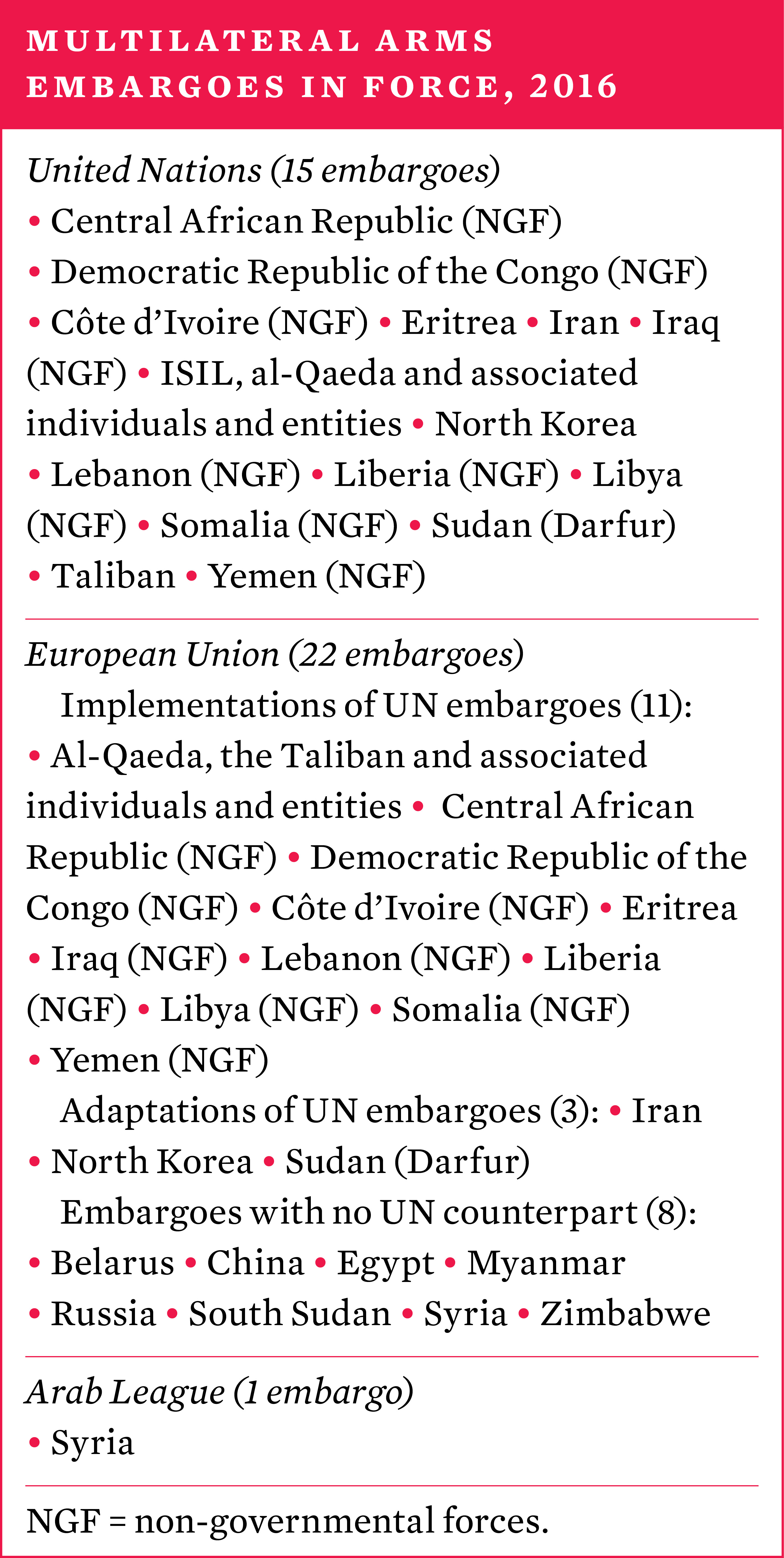15. Dual-use and arms trade controls
Overview, Sibylle Bauer [PDF]
I. The Arms Trade Treaty, Mark Bromley [PDF]
II. Multilateral embargoes on arms and dual-use items, Mark Bromley, Noel Kelly and Pieter D. Wezeman [PDF]
III. The export control regimes, Sibylle Bauer and Giovanna Maletta [PDF]
IV. Developments in EU dual-use and arms trade controls, Sibylle and Mark Bromley [PDF]
V. Human rights, the European Union and dual-use export controls, Mark Bromley [PDF]
The Arms Trade Treaty
An Extraordinary Meeting of States Parties (CSP1.5) to the Arms Trade Treaty (ATT) took place in February 2016 and the Second Conference of States Parties (CSP2) took place in August 2016. At the February meeting, key decisions were taken in relation to the role and functioning of the ATT Secretariat. At CSP2 consensus was achieved on the permanent Head of the ATT Secretariat, Dumisani Dladla; the reporting templates recommended for the initial report on treaty implementation and the Annual Report on Arms Transfers; draft terms of reference for the ATT Voluntary Trust Fund; and the setting up of Intersessional Working Groups on Effective Implementation of the ATT, Treaty Universalization, and Transparency and Reporting. Major challenges remain with regard to the practical impact of the ATT: the low levels of accession in Asia and the Middle East; the commercial and political considerations shaping the interpretation of treaty provisions; the fact that important arms-supplying and recipient states remain outside the treaty; and the limitations on the role and capacities of the Secretariat.
Multilateral arms embargoes
In 2016 there were 38 multilateral arms embargoes in force: 15 imposed by the United Nations, 22 by the European Union (EU) and 1 by the League of Arab States. Of the EU embargoes, 11 directly implemented UN decisions, 3 implemented UN embargoes with modified geographical scope or coverage in terms of the weapon types included and 8 had no UN counter-part. The single Arab League arms embargo (on Syria) had no UN counterpart. Most of these embargoes only cover conventional arms. However, the UN and EU embargoes on Iran and North Korea, and the EU embargo on Russia also cover exports of dual-use goods. No new multilateral arms embargoes were imposed in 2016. Implementation of the UN embargoes was again not without problems, as demonstrated by the reports of the different panels of experts charged with monitoring their implementation.

Export control regimes
All the multilateral export control regimes—the Australia Group, the Missile Technology Control Regime (MTCR), the Nuclear Suppliers Group and the Wassenaar Arrangement on Export Controls for Conventional Arms and Dual-use Goods and Technologies (Wassenaar Arrangement, WA)—sought to update their respective trade control lists and guide-lines. Most of the regimes continued to face difficulties with admitting new members, owing to the requirement that all existing members must approve the application. However, in June 2016 India finally got one step closer to its goal of joining the export control regimes by becoming a participating state in the MTCR and in The Hague Code of Conduct against Ballistic Missile Proliferation. Discussions continued in all the regimes about how to better engage with non-participating states. Several of the regimes conducted broader outreach dialogues that went beyond technical briefings.
EU dual-use trade controls
The EU’s revision of its Regulation on the export, transit and brokering of dual-use items continued throughout 2016. It is unlikely to reach a conclusion before 2018. In September 2016 the European Commission put forward a legislative proposal that includes several elements that have provoked negative reactions from industry and several EU member states, and would constitute a fundamental change to aspects of the EU dual-use control regime. The elements were: an expansion of the definition of dual-use items to include certain types of cyber-surveillance technology; an EU control list that for the first time goes beyond the lists of the four export control regimes; an expansion of the so-called catch-all controls for unlisted items to cover items that may be intended to be used in violations of human rights or international humanitarian law or in connection with acts of terrorism; and an expansion of the criteria that states are required to apply when assessing licence applications to include issues related to human rights, international humanitarian law and terrorism.
Applying human rights concerns to dual-use export controls
The application of human rights norms to arms export controls has been broadly accepted for many years. However, their application to dual-use export controls has always been less clear-cut and more uneven. This issue has received increased attention largely as a result of the addition of a number of information and communications technology surveillance systems to the WA and EU dual-use lists. These items have been identified largely owing to the human rights concerns associated with their use. Their inclusion in the WA and EU dual-use lists has led to calls for a further expansion in the range of such surveillance systems that are subject to control. At the EU level, this has also fed into discussions about establishing a clearer connection between dual-use export controls and the application of human rights norms.